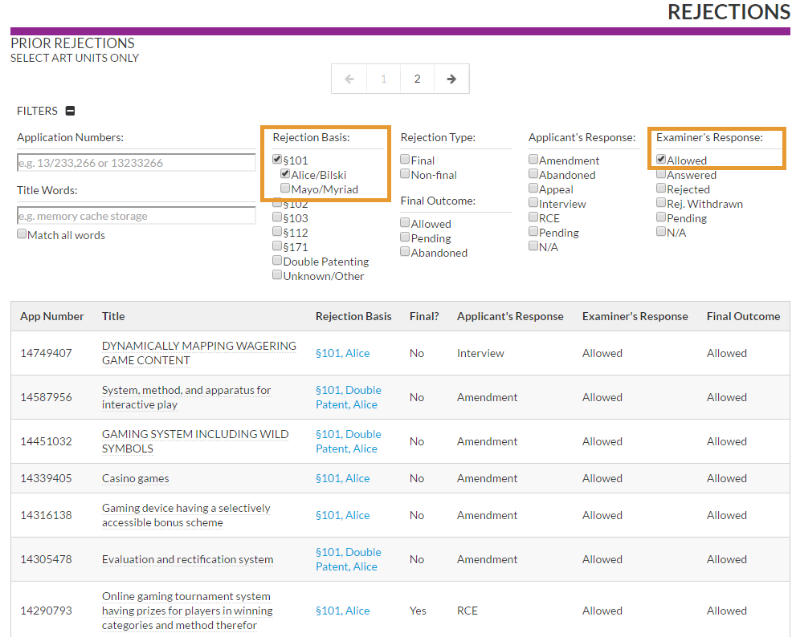Introduction
If you’re reading this, you’re already familiar with Alice Corp. v. CLS Bank or you’re my mother. Either way, it’s unnecessary to recite all the details of the case or the subsequent aftermath. Suffice it to say that Alice created some serious doubts about the patentability of software claims, particularly as they relate to business methods.
Readers are probably more interested to learn that there are effective strategies for overcoming Alice rejections. Here are three tips that will help if (when) you fall victim to the case:
Tip #1: Avoid Alice All Together
When most prosecutors think of Alice, they probably picture the pit of despair we call Tech Center 3600. As demonstrated below, there’s good reason for this. Juristat’s patent analytics show Tech Center 3600 is responsible for 66% of all Alice rejections. Tech Center 3700, the second most affected tech center, clocks in at only 14%. In fact, as shown in Figure 2, all five art units with the most Alice rejections hail from Tech Center 3600.
While these numbers are staggering, a recent study by Juristat shows that class, rather than tech center, is a better predictor of an application’s likelihood of receiving an Alice rejection. I won’t rehash the details here, but one thing is clear: if you can avoid a specific classification, you can greatly decrease your chances of getting an Alice rejection.
So, how does one avoid a specific classification? With data. Using a tool like Juristat Etro, a patent attorney can input claim language and quickly see where an application is likely to end up. The tool will highlight the words causing a specific classification and suggest synonyms. Within minutes, an attorney can drastically decrease an application’s chances of ending up in an Alice-heavy class.
In short, the best way to overcome an Alice rejection is to avoid one altogether. You can do that with big data.
Tip #2: Know Your Examiner
As surprising as it may seem, patent examiners are people, too. People have inherent biases based on individual experience. This means patent law is not purely objective and outcomes cannot be predicted on merit alone. To predict your examiner’s future, it’s necessary to understand their past.
But how does one learn about an examiner’s past? Surprise! With data. Using patent examiner analytics, it’s easier than ever to see how a given examiner applied Alice in the past. A trial attorney wouldn’t argue a case without a thorough understanding of the precedent, so why should a patent attorney be any different? Using a tool like Juristat Patent Examiner Reports, you can quickly see how many Alice rejections your examiner has issued. You can also see how many of those were allowed. Using this knowledge, it’s simple to pull out successful arguments and see which type of office action responses are most effective. This is your precedent.

Tip #3: Just Ask Your Examiner
Of course, data isn’t always available. In the absence of powerful patent analytics, consider a more traditional method: ask the examiner what they want to see. When Patrick Miller, Senior Attorney at Oblon, is confronted with a subject matter rejection, he recommends an interview with the examiner before filing a formal response. According to Mr. Miller:
This approach addresses the issue in a timely, effective and efficient manner in that we are able to quickly understand what a particular Examiner is looking for to overcome the 101 non-statutory subject matter rejection without filing ineffective or unnecessary arguments or claim changes.
Alan Kagen and his colleagues at Nixon & Vanderhye take a similar approach. According to Mr. Kagen, it’s necessary to combine a deep understanding of the client’s technology with an analysis of the case law cited by the examiner. “This often takes the form of an interview with the Examiner,” says Mr. Kagen, “where we can discuss the client’s invention with the Examiner and illustrate how the current case law supports patent eligibility.”
Conclusion
While Alice has caused tremendous anxiety and frustration, hope is not lost. If you can avoid Alice altogether, you’re in good shape. Otherwise, it helps to know your examiner’s history of such rejections. Finally, in the absence of big data, talk to your examiner. As demonstrated above, this method is trusted by some extremely successful prosecutors.
Of course, there are countless ways to approach an Alice rejection. If you use a different approach, I’d love to hear from you.
(gradient).webp)

